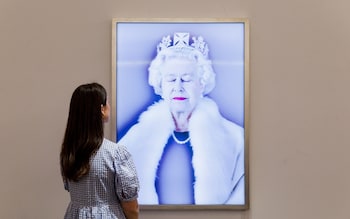An 1861 painting by a little-known female artist has just been bought by the Manchester Art Gallery for £130,000. While its satirical depiction of the inferior roles assigned to working women is entirely appropriate for a city which, 40 years later, saw the birth of the suffragette movement, the price itself is also significant. It is double the artist’s auction record which the same picture made at Sotheby’s last year, and 44 times the price it made in 1982, also at Sotheby’s. It begs the question: are Victorian women artists bucking the downward trend of the Victorian art market in general?
The visually striking painting, Woman’s Work: A Medley is currently featured in Tate Britain’s Now You See Us: Women Artists in Britain 1520-1920, (on view until October 13). It depicts a sybaritic male lounging oafishly on a red throne, surrounded by a bevy of fawning females seeking his attention. Behind him stands a statue of a golden calf, a symbol of the worship of false gods, with a plaque inscribed: “the proper study of woman is man.” Among the medley of scenes depicted is one of a woman examining a scroll held by a clergyman, with a list of ‘lawful’ job opportunities from ‘Sunday School’ and ‘Charity’ to ‘Reading and Writing Tracts’. It ends with ‘Triviality’. Such were the aspirational limits of middle-class women in mid-Victorian times. The artist, Florence Claxton (1838-1920), is most closely associated with periodicals such as The Illustrated Times for which she made satirical sketches.
But apart from that she had little success perhaps because collectors found her subjects too controversial. She could not sell Woman’s Work in exhibitions, and its performance at auction in 1874 was not recorded. The painting then sank without trace for over a century, until it surfaced at auction in 1982 when it sold without competition for £3,300.
In the following years, the Victorian art market experienced a boom in which regular specialised sales of Victorian art at Sotheby’s, Christie’s and Phillips would make millions. But then, the big money retreated from Victorian sentiment. The exceptions to the downward trend are Pre-Raphaelites and previously underrated women artists. In the Tate show, for example, is Eleanor Fortescue-Brickdale’s The Pale Complexion of Pure Love, 1899, which, having changed hands in 1993 for £36,700 was bought for the Musée d’Orsay two years ago for around £300,000, and Louise Jopling’s enigmatic A Modern Cinderella, 1875, that was sold at Bonhams in 1999 for £2,200, and then in America in 2019 for £185,000.
Much of the revaluation work was done by feminist art historians such as Jan Marsh and Deborah Cherry who influenced both the marketplace and their students who have since become curators. In 1997, Woman’s Work was described by Catherine King in the Dictionary of Women Artists as “the first consciously feminist allegory.” But how much does that count for in the market? In March 2023, the painting appeared again at Sotheby’s – in a Women Artists sale (designed to tap into the burgeoning market for women artists generally), rather than a Victorian art sale. Here, it was estimated at just £15,000 – not much more than an ambitious youngster might ask in their graduation show. Spotting its potential, Victorian art dealer Martin Beisly bid on it but was outgunned by a private collector at £69,850. The whole auction process was too speedy for a museum with its lengthy approval procedures to take part in.

Louise Jopling’s A Modern Cinderella, 1875
Credit: Tate Britain
After the sale, Beisly learned who the buyer was when they approached him to see if he could sell it for more. He approached the Manchester Gallery and found its curators positively responsive. It was the perfect foil for Ford Madox Brown’s male orientated Work, already in their collection, and an ideal fulfilment of the collection’s gender diverse ambitions and educational responsibilities.
Thus, a campaign was launched to buy it. Last month with the help of the Art Fund charity (£52,000) and Arts Council England’s V&A Purchase Grant Fund (£50,000) the target was reached. However, while Woman’s Work bucked the trend, the majority of the Victorian market remains a bargain hunter’s paradise.
A heavyweight sculptor celebrates the Paris Olympics




Bernar Venet : Convergence: 54.5˚ Arc x 14
Nibs Bernar Venet, 83, is one of France’s most successful living sculptors, best known for his series of massive Corten steel curved Arc sculptures that seem to defy gravity. One 22-foot-wide example from the series set his auction record of £775,000 in 2021. Not surprisingly, Venet was commissioned by the French to make a work to impress visitors to the Paris Olympics. His dynamic, 59-foot tall, 43 tonnes Convergence 54.5 Arc x14 work is prominently displayed in the ZAC Plaine Saulnier near the Stade de France and the specially constructed Aquatic Centre in St Denis.
In London, Venet is represented by Waddington Custot in Cork Street, whose owner, Stephane Custot, describes the work as providing a “wow” factor to the Games and says he will show other examples of his work in London next year. In terms of cross-channel competition, Venet’s Olympic Arc is dwarfed by Britain’s comparable commission – Anish Kapoor’s 375-foot slide made for London’s Queen Elizabeth Olympic Park in 2012. Kapoor’s auction record also surpasses Venet’s at close to £2 million. Other living British sculptors to outshine the Frenchman at auction are Tony Cragg (record £850,000), Antony Gormley (£5 million) and Damien Hirst (£10.3 million).
Legal battle over portrait of the late Queen




Chris Levine’s Lightness of Being, 2022
Credit: Tristan Fewings/Getty Images for Sotheby’s
The Jersey Heritage Trust, which commissioned light artist Chris Levine to take his now celebrated photographs of the late Queen Elizabeth II, Equanimity (eyes open) in 2003 and Lightness of Being (with eyes closed) in 2004, are suing the artist and his company over a disputed copyright issue and lost royalty revenue on sales.
According to a report by The Art Newspaper, Jersey calculates that between 2015 (when an initial settlement was reached from which £100,000 is still owed to them) and 2023, further sales have amounted to £3.7 million, which means some £650,000 in royalties is now due. The report adds that the artist has contested the calculations and declared insufficient funds to complete such payment. The case is ongoing in the Chancery Division of the High Court of Justice.
The auction record for Levine was set this May when a glowingly coloured 5 x 6 foot print of Lightness of Being decorated with Swarovski crystals sold for £475,000 at a charity sale conducted by Simon de Pury in Cannes to raise funds for amfAR, the Aids research foundation.



